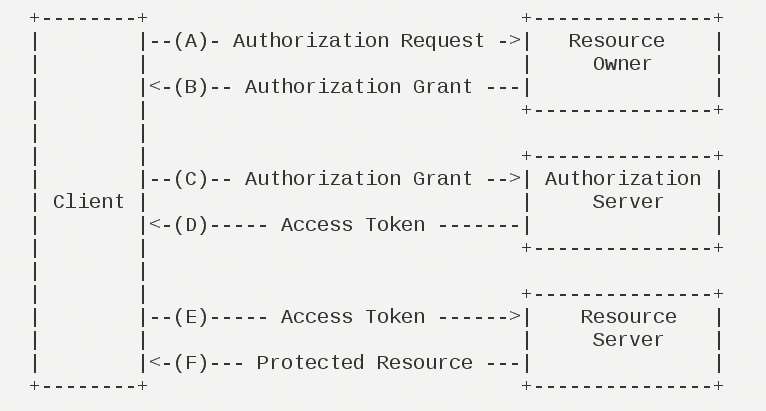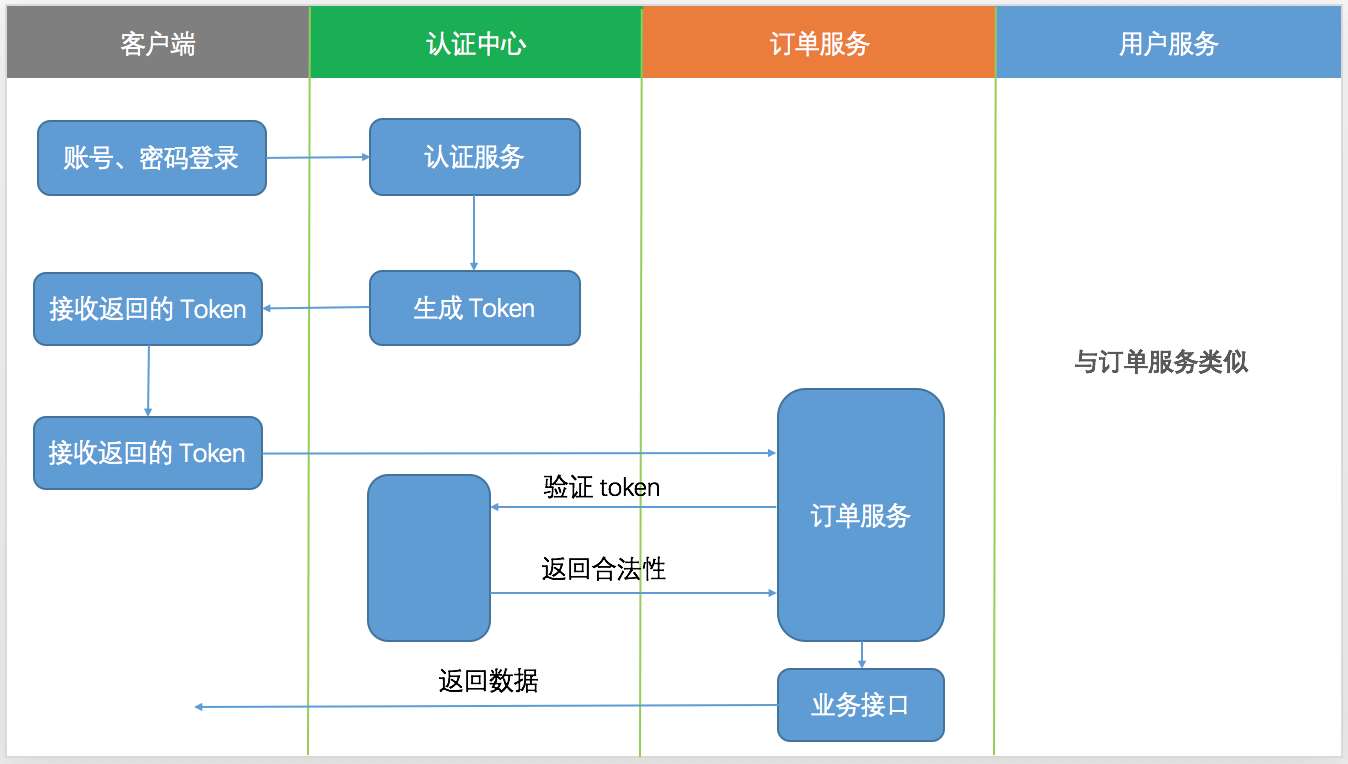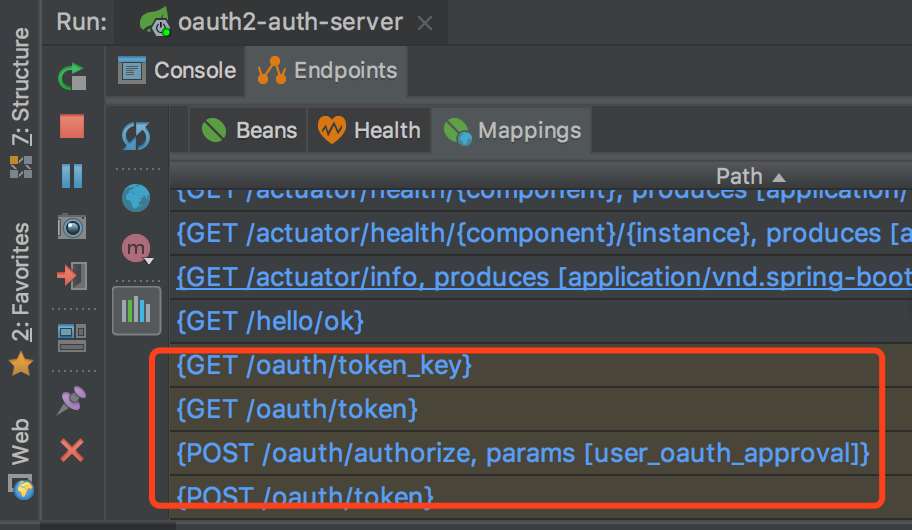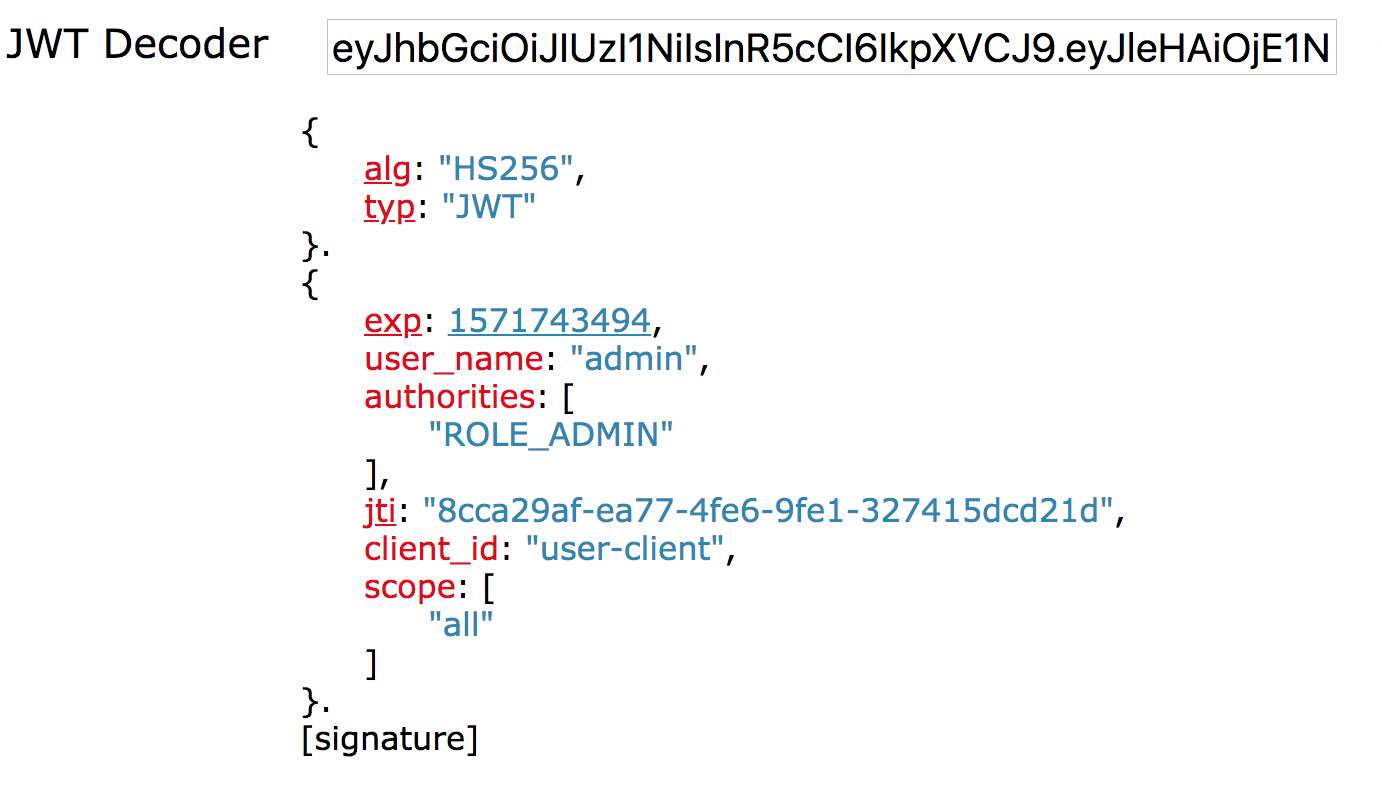您好,登錄后才能下訂單哦!
您好,登錄后才能下訂單哦!
小編給大家分享一下Spring Cloud OAuth2如何實現用戶認證及單點登錄,相信大部分人都還不怎么了解,因此分享這篇文章給大家參考一下,希望大家閱讀完這篇文章后大有收獲,下面讓我們一起去了解一下吧!
OAuth 2 有四種授權模式,分別是授權碼模式(authorization code)、簡化模式(implicit)、密碼模式(resource owner password credentials)、客戶端模式(client credentials),具體 OAuth3 是什么,可以參考這篇文章。(http://www.ruanyifeng.com/blog/2014/05/oauth_2_0.html)

本文我們將使用授權碼模式和密碼模式兩種方式來實現用戶認證和授權管理。
OAuth3 其實是一個關于授權的網絡標準,它制定了設計思路和運行流程,利用這個標準我們其實是可以自己實現 OAuth3 的認證過程的。今天要介紹的 spring-cloud-starter-oauth3 ,其實是 Spring Cloud 按照 OAuth3 的標準并結合 spring-security 封裝好的一個具體實現。
什么情況下需要用 OAuth3
首先大家最熟悉的就是幾乎每個人都用過的,比如用微信登錄、用 QQ 登錄、用微博登錄、用 Google 賬號登錄、用 github 授權登錄等等,這些都是典型的 OAuth3 使用場景。假設我們做了一個自己的服務平臺,如果不使用 OAuth3 登錄方式,那么我們需要用戶先完成注冊,然后用注冊號的賬號密碼或者用手機驗證碼登錄。而使用了 OAuth3 之后,相信很多人使用過、甚至開發過公眾號網頁服務、小程序,當我們進入網頁、小程序界面,第一次使用就無需注冊,直接使用微信授權登錄即可,大大提高了使用效率。因為每個人都有微信號,有了微信就可以馬上使用第三方服務,這體驗不要太好了。而對于我們的服務來說,我們也不需要存儲用戶的密碼,只要存儲認證平臺返回的唯一ID 和用戶信息即可。
以上是使用了 OAuth3 的授權碼模式,利用第三方的權威平臺實現用戶身份的認證。當然了,如果你的公司內部有很多個服務,可以專門提取出一個認證中心,這個認證中心就充當上面所說的權威認證平臺的角色,所有的服務都要到這個認證中心做認證。
這樣一說,發現沒,這其實就是個單點登錄的功能。這就是另外一種使用場景,對于多服務的平臺,可以使用 OAuth3 實現服務的單點登錄,只做一次登錄,就可以在多個服務中自由穿行,當然僅限于授權范圍內的服務和接口。
實現統一認證功能
本篇先介紹密碼模式實現的單點登錄,下一篇再繼續說授權碼模式。
在微服務橫行的今天,誰敢說自己手上沒幾個微服務。微服務減少了服務間的耦合,同時也在某些方面增加了系統的復雜度,比如說用戶認證。假設我們這里實現了一個電商平臺,用戶看到的就是一個 APP 或者一個 web 站點,實際上背后是由多個獨立的服務構成的,比如用戶服務、訂單服務、產品服務等。用戶只要第一次輸入用戶名、密碼完成登錄后,一段時間內,都可以任意訪問各個頁面,比如產品列表頁面、我的訂單頁面、我的關注等頁面。
我們可以想象一下,自然能夠想到,在請求各個服務、各個接口的時候,一定攜帶著什么憑證,然后各個服務才知道請求接口的用戶是哪個,不然肯定有問題,那其實這里面的憑證簡單來說就是一個 Token,標識用戶身份的 Token。
系統架構說明
認證中心:oauth3-auth-server,OAuth3 主要實現端,Token 的生成、刷新、驗證都在認證中心完成。
訂單服務:oauth3-client-order-server,微服務之一,接收到請求后會到認證中心驗證。
用戶服務:oauth3-client-user-server,微服務之二,接收到請求后會到認證中心驗證。
客戶端:例如 APP 端、web 端 等終端

上圖描述了使用了 OAuth3 的客戶端與微服務間的請求過程。大致的過程就是客戶端用用戶名和密碼到認證服務端換取 token,返回給客戶端,客戶端拿著 token 去各個微服務請求數據接口,一般這個 token 是放到 header 中的。當微服務接到請求后,先要拿著 token 去認證服務端檢查 token 的合法性,如果合法,再根據用戶所屬的角色及具有的權限動態的返回數據。
創建并配置認證服務端
配置最多的就是認證服務端,驗證賬號、密碼,存儲 token,檢查 token ,刷新 token 等都是認證服務端的工作。
1、引入需要的 maven 包
<dependency> <groupId>org.springframework.boot</groupId> <artifactId>spring-boot-starter-web</artifactId> </dependency> <dependency> <groupId>org.springframework.cloud</groupId> <artifactId>spring-cloud-starter-oauth3</artifactId> </dependency> <dependency> <groupId>org.springframework.boot</groupId> <artifactId>spring-boot-starter-data-redis</artifactId> </dependency> <dependency> <groupId>org.springframework.boot</groupId> <artifactId>spring-boot-starter-actuator</artifactId> </dependency>
spring-cloud-starter-oauth3包含了 spring-cloud-starter-security,所以不用再單獨引入了。之所以引入 redis 包,是因為下面會介紹一種用 redis 存儲 token 的方式。
2、配置好 application.yml
將項目基本配置設置好,并加入有關 redis 的配置,稍后會用到。
spring: application: name: auth-server redis: database: 2 host: localhost port: 32768 password: 1qaz@WSX jedis: pool: max-active: 8 max-idle: 8 min-idle: 0 timeout: 100ms server: port: 6001 management: endpoint: health: enabled: true
3、spring security 基礎配置
@EnableWebSecurity
public class WebSecurityConfig extends WebSecurityConfigurerAdapter {
@Bean
public PasswordEncoder passwordEncoder() {
return new BCryptPasswordEncoder();
}
@Bean
@Override
public AuthenticationManager authenticationManagerBean() throws Exception {
return super.authenticationManagerBean();
}
/**
* 允許匿名訪問所有接口 主要是 oauth 接口
* @param http
* @throws Exception
*/
@Override
protected void configure(HttpSecurity http) throws Exception {
http.authorizeRequests()
.antMatchers("/**").permitAll();
}
}使用@EnableWebSecurity注解修飾,并繼承自WebSecurityConfigurerAdapter類。
這個類的重點就是聲明 PasswordEncoder 和 AuthenticationManager兩個 Bean。稍后會用到。其中 BCryptPasswordEncoder是一個密碼加密工具類,它可以實現不可逆的加密,AuthenticationManager是為了實現 OAuth3 的 password 模式必須要指定的授權管理 Bean。
4、實現 UserDetailsService
如果你之前用過 Security 的話,那肯定對這個類很熟悉,它是實現用戶身份驗證的一種方式,也是最簡單方便的一種。另外還有結合 AuthenticationProvider的方式,有機會講 Security 的時候再展開來講吧。
UserDetailsService的核心就是 loadUserByUsername方法,它要接收一個字符串參數,也就是傳過來的用戶名,返回一個 UserDetails對象。
@Slf4j
@Component(value = "kiteUserDetailsService")
public class KiteUserDetailsService implements UserDetailsService {
@Autowired
private PasswordEncoder passwordEncoder;
@Override
public UserDetails loadUserByUsername(String username) throws UsernameNotFoundException {
log.info("usernameis:" + username);
// 查詢數據庫操作
if(!username.equals("admin")){
throw new UsernameNotFoundException("the user is not found");
}else{
// 用戶角色也應在數據庫中獲取
String role = "ROLE_ADMIN";
List<SimpleGrantedAuthority> authorities = new ArrayList<>();
authorities.add(new SimpleGrantedAuthority(role));
// 線上環境應該通過用戶名查詢數據庫獲取加密后的密碼
String password = passwordEncoder.encode("123456");
return new org.springframework.security.core.userdetails.User(username,password, authorities);
}
}
}這里為了做演示,把用戶名、密碼和所屬角色都寫在代碼里了,正式環境中,這里應該是從數據庫或者其他地方根據用戶名將加密后的密碼及所屬角色查出來的。賬號 admin ,密碼 123456,稍后在換取 token 的時候會用到。并且給這個用戶設置 "ROLE_ADMIN" 角色。
5、OAuth3 配置文件
創建一個配置文件繼承自 AuthorizationServerConfigurerAdapter.
@Configuration
@EnableAuthorizationServer
public class OAuth3Config extends AuthorizationServerConfigurerAdapter {
@Autowired
public PasswordEncoder passwordEncoder;
@Autowired
public UserDetailsService kiteUserDetailsService;
@Autowired
private AuthenticationManager authenticationManager;
@Autowired
private TokenStore redisTokenStore;
@Override
public void configure(final AuthorizationServerEndpointsConfigurer endpoints) throws Exception {
/**
* redis token 方式
*/
endpoints.authenticationManager(authenticationManager)
.userDetailsService(kiteUserDetailsService)
.tokenStore(redisTokenStore);
}
@Override
public void configure(ClientDetailsServiceConfigurer clients) throws Exception {
clients.inMemory()
.withClient("order-client")
.secret(passwordEncoder.encode("order-secret-8888"))
.authorizedGrantTypes("refresh_token", "authorization_code", "password")
.accessTokenValiditySeconds(3600)
.scopes("all")
.and()
.withClient("user-client")
.secret(passwordEncoder.encode("user-secret-8888"))
.authorizedGrantTypes("refresh_token", "authorization_code", "password")
.accessTokenValiditySeconds(3600)
.scopes("all");
}
@Override
public void configure(AuthorizationServerSecurityConfigurer security) throws Exception {
security.allowFormAuthenticationForClients();
security.checkTokenAccess("isAuthenticated()");
security.tokenKeyAccess("isAuthenticated()");
}
}有三個 configure 方法的重寫。
AuthorizationServerEndpointsConfigurer參數的重寫
endpoints.authenticationManager(authenticationManager) .userDetailsService(kiteUserDetailsService) .tokenStore(redisTokenStore);
authenticationManage() 調用此方法才能支持 password 模式。
userDetailsService() 設置用戶驗證服務。
tokenStore() 指定 token 的存儲方式。
redisTokenStore Bean 的定義如下:
@Configuration
public class RedisTokenStoreConfig {
@Autowired
private RedisConnectionFactory redisConnectionFactory;
@Bean
public TokenStore redisTokenStore (){
return new RedisTokenStore(redisConnectionFactory);
}
}ClientDetailsServiceConfigurer參數的重寫,在這里定義各個端的約束條件。包括
ClientId、Client-Secret:這兩個參數對應請求端定義的 cleint-id 和 client-secret
authorizedGrantTypes 可以包括如下幾種設置中的一種或多種:
authorization_code:授權碼類型。
implicit:隱式授權類型。
password:資源所有者(即用戶)密碼類型。
client_credentials:客戶端憑據(客戶端ID以及Key)類型。
refresh_token:通過以上授權獲得的刷新令牌來獲取新的令牌。
accessTokenValiditySeconds:token 的有效期
scopes:用來限制客戶端訪問的權限,在換取的 token 的時候會帶上 scope 參數,只有在 scopes 定義內的,才可以正常換取 token。
上面代碼中是使用 inMemory 方式存儲的,將配置保存到內存中,相當于硬編碼了。正式環境下的做法是持久化到數據庫中,比如 mysql 中。
具體的做法如下:
在數據庫中增加表,并插入數據
create table oauth_client_details (
client_id VARCHAR(256) PRIMARY KEY,
resource_ids VARCHAR(256),
client_secret VARCHAR(256),
scope VARCHAR(256),
authorized_grant_types VARCHAR(256),
web_server_redirect_uri VARCHAR(256),
authorities VARCHAR(256),
access_token_validity INTEGER,
refresh_token_validity INTEGER,
additional_information VARCHAR(4096),
autoapprove VARCHAR(256)
);
INSERT INTO oauth_client_details
(client_id, client_secret, scope, authorized_grant_types,
web_server_redirect_uri, authorities, access_token_validity,
refresh_token_validity, additional_information, autoapprove)
VALUES
('user-client', '$2a$10$o2l5kA7z.Caekp72h6kU7uqdTDrlamLq.57M1F6ulJln9tRtOJufq', 'all',
'authorization_code,refresh_token,password', null, null, 3600, 36000, null, true);
INSERT INTO oauth_client_details
(client_id, client_secret, scope, authorized_grant_types,
web_server_redirect_uri, authorities, access_token_validity,
refresh_token_validity, additional_information, autoapprove)
VALUES
('order-client', '$2a$10$GoIOhjqFKVyrabUNcie8d.ADX.qZSxpYbO6YK4L2gsNzlCIxEUDlW', 'all',
'authorization_code,refresh_token,password', null, null, 3600, 36000, null, true);注意: client_secret 字段不能直接是 secret 的原始值,需要經過加密。因為是用的 BCryptPasswordEncoder,所以最終插入的值應該是經過 BCryptPasswordEncoder.encode()之后的值。
然后在配置文件 application.yml 中添加關于數據庫的配置
spring: datasource: url: jdbc:mysql://localhost:3306/spring_cloud?characterEncoding=UTF-8&useSSL=false username: root password: password hikari: connection-timeout: 30000 idle-timeout: 600000 max-lifetime: 1800000 maximum-pool-size: 9
Spring Boot 2.0 之后默認使用 hikari 作為數據庫連接池。如果使用其他連接池需要引入相關包,然后對應的增加配置。
在 OAuth3 配置類(OAuth3Config)中增加 DataSource 的注入
@Autowired private DataSource dataSource;
將 public void configure(ClientDetailsServiceConfigurer clients)重寫方法修改為如下:
@Override
public void configure(ClientDetailsServiceConfigurer clients) throws Exception {
JdbcClientDetailsServiceBuilder jcsb = clients.jdbc(dataSource);
jcsb.passwordEncoder(passwordEncoder);
}還有一個重寫的方法 public void configure(AuthorizationServerSecurityConfigurer security),這個方法限制客戶端訪問認證接口的權限。
security.allowFormAuthenticationForClients();
security.checkTokenAccess("isAuthenticated()");
security.tokenKeyAccess("isAuthenticated()");第一行代碼是允許客戶端訪問 OAuth3 授權接口,否則請求 token 會返回 401。
第二行和第三行分別是允許已授權用戶訪問 checkToken 接口和獲取 token 接口。
完成之后,啟動項目,如果你用的是 IDEA 會在下方的 Mapping 窗口中看到 oauth3 相關的 RESTful 接口。

主要有如下幾個:
POST /oauth/authorize 授權碼模式認證授權接口
GET/POST /oauth/token 獲取 token 的接口
POST /oauth/check_token 檢查 token 合法性接口
上面創建完成了認證服務端,下面開始創建一個客戶端,對應到我們系統中的業務相關的微服務。我們假設這個微服務項目是管理用戶相關數據的,所以叫做用戶客戶端。
1、引用相關的 maven 包
<dependency> <groupId>org.springframework.boot</groupId> <artifactId>spring-boot-starter-web</artifactId> </dependency> <dependency> <groupId>org.springframework.cloud</groupId> <artifactId>spring-cloud-starter-oauth3</artifactId> </dependency> <dependency> <groupId>org.springframework.boot</groupId> <artifactId>spring-boot-starter-data-redis</artifactId> </dependency>
2、application.yml 配置文件
spring: application: name: client-user redis: database: 2 host: localhost port: 32768 password: 1qaz@WSX jedis: pool: max-active: 8 max-idle: 8 min-idle: 0 timeout: 100ms server: port: 6101 servlet: context-path: /client-user security: oauth3: client: client-id: user-client client-secret: user-secret-8888 user-authorization-uri: http://localhost:6001/oauth/authorize access-token-uri: http://localhost:6001/oauth/token resource: id: user-client user-info-uri: user-info authorization: check-token-access: http://localhost:6001/oauth/check_token
上面是常規配置信息以及 redis 配置,重點是下面的 security 的配置,這里的配置稍有不注意就會出現 401 或者其他問題。
client-id、client-secret 要和認證服務中的配置一致,如果是使用 inMemory 還是 jdbc 方式。
user-authorization-uri 是授權碼認證方式需要的,下一篇文章再說。
access-token-uri 是密碼模式需要用到的獲取 token 的接口。
authorization.check-token-access 也是關鍵信息,當此服務端接收到來自客戶端端的請求后,需要拿著請求中的 token 到認證服務端做 token 驗證,就是請求的這個接口
3、資源配置文件
在 OAuth3 的概念里,所有的接口都被稱為資源,接口的權限也就是資源的權限,所以 Spring Security OAuth3 中提供了關于資源的注解 @EnableResourceServer,和 @EnableWebSecurity的作用類似。
@Configuration
@EnableResourceServer
@EnableGlobalMethodSecurity(prePostEnabled = true)
public class ResourceServerConfig extends ResourceServerConfigurerAdapter {
@Value("${security.oauth3.client.client-id}")
private String clientId;
@Value("${security.oauth3.client.client-secret}")
private String secret;
@Value("${security.oauth3.authorization.check-token-access}")
private String checkTokenEndpointUrl;
@Autowired
private RedisConnectionFactory redisConnectionFactory;
@Bean
public TokenStore redisTokenStore (){
return new RedisTokenStore(redisConnectionFactory);
}
@Bean
public RemoteTokenServices tokenService() {
RemoteTokenServices tokenService = new RemoteTokenServices();
tokenService.setClientId(clientId);
tokenService.setClientSecret(secret);
tokenService.setCheckTokenEndpointUrl(checkTokenEndpointUrl);
return tokenService;
}
@Override
public void configure(ResourceServerSecurityConfigurer resources) throws Exception {
resources.tokenServices(tokenService());
}
}因為使用的是 redis 作為 token 的存儲,所以需要特殊配置一下叫做 tokenService 的 Bean,通過這個 Bean 才能實現 token 的驗證。
4、最后,添加一個 RESTful 接口
@Slf4j
@RestController
public class UserController {
@GetMapping(value = "get")
//@PreAuthorize("hasAuthority('ROLE_ADMIN')")
@PreAuthorize("hasAnyRole('ROLE_ADMIN')")
public Object get(Authentication authentication){
//Authentication authentication = SecurityContextHolder.getContext().getAuthentication();
authentication.getCredentials();
OAuth3AuthenticationDetails details = (OAuth3AuthenticationDetails)authentication.getDetails();
String token = details.getTokenValue();
return token;
}
}一個 RESTful 方法,只有當訪問用戶具有 ROLE_ADMIN 權限時才能訪問,否則返回 401 未授權。
通過 Authentication 參數或者 SecurityContextHolder.getContext().getAuthentication() 可以拿到授權信息進行查看。
測試認證功能
1、啟動認證服務端,啟動端口為 6001
2、啟動用戶服務客戶端,啟動端口為6101
3、請求認證服務端獲取 token
我是用 REST Client 來做訪問請求的,請求格式如下:
POST http://localhost:6001/oauth/token?grant_type=password&username=admin&password=123456&scope=all Accept: */* Cache-Control: no-cache Authorization: Basic dXNlci1jbGllbnQ6dXNlci1zZWNyZXQtODg4OA==
假設咱們在一個 web 端使用,grant_type 是 password,表明這是使用 OAuth3 的密碼模式。
username=admin 和 password=123456 就相當于在 web 端登錄界面輸入的用戶名和密碼,我們在認證服務端配置中固定了用戶名是 admin 、密碼是 123456,而線上環境中則應該通過查詢數據庫獲取。
scope=all 是權限有關的,在認證服務的 OAuthConfig 中指定了 scope 為 all 。
Authorization 要加在請求頭中,格式為 Basic 空格 base64(clientId:clientSecret),這個微服務客戶端的 client-id 是 user-client,client-secret 是 user-secret-8888,將這兩個值通過冒號連接,并使用 base64 編碼(user-client:user-secret-8888)之后的值為 dXNlci1jbGllbnQ6dXNlci1zZWNyZXQtODg4OA==,可以通過 https://www.sojson.com/base64.html 在線編碼獲取。

運行請求后,如果參數都正確的話,獲取到的返回內容如下,是一段 json 格式
{
"access_token": "9f958300-5005-46ea-9061-323c9e6c7a4d",
"token_type": "bearer",
"refresh_token": "0f5871f5-98f1-405e-848e-80f641bab72e",
"expires_in": 3599,
"scope": "all"
}access_token : 就是之后請求需要帶上的 token,也是本次請求的主要目的
token_type:為 bearer,這是 access token 最常用的一種形式
refresh_token:之后可以用這個值來換取新的 token,而不用輸入賬號密碼
expires_in:token 的過期時間(秒)
4、用獲取到的 token 請求資源接口
我們在用戶客戶端中定義了一個接口 http://localhost:6101/client-user/get,現在就拿著上一步獲取的 token 來請求這個接口。
GET http://localhost:6101/client-user/get Accept: */* Cache-Control: no-cache Authorization: bearer ce334918-e666-455a-8ecd-8bd680415d84
同樣需要請求頭 Authorization,格式為 bearer + 空格 + token,正常情況下根據接口的邏輯,會把 token 原樣返回。
5、token 過期后,用 refresh_token 換取 access_token
一般都會設置 access_token 的過期時間小于 refresh_token 的過期時間,以便在 access_token 過期后,不用用戶再次登錄的情況下,獲取新的 access_token。
### 換取 access_token POST http://localhost:6001/oauth/token?grant_type=refresh_token&refresh_token=706dac10-d48e-4795-8379-efe8307a2282 Accept: */* Cache-Control: no-cache Authorization: Basic dXNlci1jbGllbnQ6dXNlci1zZWNyZXQtODg4OA==
grant_type 設置為 refresh_token。
refresh_token 設置為請求 token 時返回的 refresh_token 的值。
請求頭加入 Authorization,格式依然是 Basic + 空格 + base64(client-id:client-secret)
請求成功后會返回和請求 token 同樣的數據格式。
用 JWT 替換 redisToken
上面 token 的存儲用的是 redis 的方案,Spring Security OAuth3 還提供了 jdbc 和 jwt 的支持,jdbc 的暫不考慮,現在來介紹用 JWT 的方式來實現 token 的存儲。
用 JWT 的方式就不用把 token 再存儲到服務端了,JWT 有自己特殊的加密方式,可以有效的防止數據被篡改,只要不把用戶密碼等關鍵信息放到 JWT 里就可以保證安全性。
認證服務端改造
先把有關 redis 的配置去掉。
添加 JwtConfig 配置類
@Configuration
public class JwtTokenConfig {
@Bean
public TokenStore jwtTokenStore() {
return new JwtTokenStore(jwtAccessTokenConverter());
}
@Bean
public JwtAccessTokenConverter jwtAccessTokenConverter() {
JwtAccessTokenConverter accessTokenConverter = new JwtAccessTokenConverter();
accessTokenConverter.setSigningKey("dev");
return accessTokenConverter;
}
}JwtAccessTokenConverter是為了做 JWT 數據轉換,這樣做是因為 JWT 有自身獨特的數據格式。如果沒有了解過 JWT ,可以搜索一下先了解一下。
更改 OAuthConfig 配置類
@Autowired
private TokenStore jwtTokenStore;
@Autowired
private JwtAccessTokenConverter jwtAccessTokenConverter;
@Override
public void configure(final AuthorizationServerEndpointsConfigurer endpoints) throws Exception {
/**
* 普通 jwt 模式
*/
endpoints.tokenStore(jwtTokenStore)
.accessTokenConverter(jwtAccessTokenConverter)
.userDetailsService(kiteUserDetailsService)
/**
* 支持 password 模式
*/
.authenticationManager(authenticationManager);
}注入 JWT 相關的 Bean,然后修改 configure(final AuthorizationServerEndpointsConfigurer endpoints) 方法為 JWT 存儲模式。
改造用戶客戶端
修改 application.yml 配置文件
security: oauth3: client: client-id: user-client client-secret: user-secret-8888 user-authorization-uri: http://localhost:6001/oauth/authorize access-token-uri: http://localhost:6001/oauth/token resource: jwt: key-uri: http://localhost:6001/oauth/token_key key-value: dev
注意認證服務端 JwtAccessTokenConverter設置的 SigningKey 要和配置文件中的 key-value 相同,不然會導致無法正常解碼 JWT ,導致驗證不通過。
ResourceServerConfig 類的配置
@Configuration
@EnableResourceServer
@EnableGlobalMethodSecurity(prePostEnabled = true)
public class ResourceServerConfig extends ResourceServerConfigurerAdapter {
@Bean
public TokenStore jwtTokenStore() {
return new JwtTokenStore(jwtAccessTokenConverter());
}
@Bean
public JwtAccessTokenConverter jwtAccessTokenConverter() {
JwtAccessTokenConverter accessTokenConverter = new JwtAccessTokenConverter();
accessTokenConverter.setSigningKey("dev");
accessTokenConverter.setVerifierKey("dev");
return accessTokenConverter;
}
@Autowired
private TokenStore jwtTokenStore;
@Override
public void configure(ResourceServerSecurityConfigurer resources) throws Exception {
resources.tokenStore(jwtTokenStore);
}
}運行請求 token 接口的請求
POST http://localhost:6001/oauth/token?grant_type=password&username=admin&password=123456&scope=all Accept: */* Cache-Control: no-cache Authorization: Basic dXNlci1jbGllbnQ6dXNlci1zZWNyZXQtODg4OA==
返回結果如下:
{
"access_token": "eyJhbGciOiJIUzI1NiIsInR5cCI6IkpXVCJ9.eyJleHAiOjE1NzE3NDM0OTQsInVzZXJfbmFtZSI6ImFkbWluIiwiYXV0aG9yaXRpZXMiOlsiUk9MRV9BRE1JTiJdLCJqdGkiOiI4Y2NhMjlhZi1lYTc3LTRmZTYtOWZlMS0zMjc0MTVkY2QyMWQiLCJjbGllbnRfaWQiOiJ1c2VyLWNsaWVudCIsInNjb3BlIjpbImFsbCJdfQ.0Ik3UwB1xjX2le5luEdtVAI_MEyu_OloRRYtPOvtvwM",
"token_type": "bearer",
"refresh_token": "eyJhbGciOiJIUzI1NiIsInR5cCI6IkpXVCJ9.eyJ1c2VyX25hbWUiOiJhZG1pbiIsInNjb3BlIjpbImFsbCJdLCJhdGkiOiI4Y2NhMjlhZi1lYTc3LTRmZTYtOWZlMS0zMjc0MTVkY2QyMWQiLCJleHAiOjE1NzE3NzU4OTQsImF1dGhvcml0aWVzIjpbIlJPTEVfQURNSU4iXSwianRpIjoiZjdkMjg4NDUtMmU2ZC00ZmRjLTg1OGYtMWNiY2RlNzI1ZmMyIiwiY2xpZW50X2lkIjoidXNlci1jbGllbnQifQ.vk_msYtbrAr93h6sK4wy6EC2_wRD_cD_UBS8O6eRziw",
"expires_in": 3599,
"scope": "all",
"jti": "8cca29af-ea77-4fe6-9fe1-327415dcd21d"
}我們已經看到返回的 token 是 JWT 格式了,到 JWT 在線解碼網站 https://jwt.io/ 或者 http://jwt.calebb.net/將 token 解碼看一下

看到了沒,user_name、client_id 等信息都在其中。
拿著返回的 token 請求用戶客戶端接口
GET http://localhost:6101/client-user/get Accept: */* Cache-Control: no-cache Authorization: bearer eyJhbGciOiJIUzI1NiIsInR5cCI6IkpXVCJ9.eyJleHAiOjE1NzE3NDM0OTQsInVzZXJfbmFtZSI6ImFkbWluIiwiYXV0aG9yaXRpZXMiOlsiUk9MRV9BRE1JTiJdLCJqdGkiOiI4Y2NhMjlhZi1lYTc3LTRmZTYtOWZlMS0zMjc0MTVkY2QyMWQiLCJjbGllbnRfaWQiOiJ1c2VyLWNsaWVudCIsInNjb3BlIjpbImFsbCJdfQ.0Ik3UwB1xjX2le5luEdtVAI_MEyu_OloRRYtPOvtvwM
增強 JWT
如果我想在 JWT 中加入額外的字段(比方說用戶的其他信息)怎么辦呢,當然可以。spring security oauth3 提供了 TokenEnhancer 增強器。其實不光 JWT ,RedisToken 的方式同樣可以。
聲明一個增強器
public class JWTokenEnhancer implements TokenEnhancer {
@Override
public OAuth3AccessToken enhance(OAuth3AccessToken oAuth3AccessToken, OAuth3Authentication oAuth3Authentication) {
Map<String, Object> info = new HashMap<>();
info.put("jwt-ext", "JWT 擴展信息");
((DefaultOAuth3AccessToken) oAuth3AccessToken).setAdditionalInformation(info);
return oAuth3AccessToken;
}
}通過 oAuth3Authentication 可以拿到用戶名等信息,通過這些我們可以在這里查詢數據庫或者緩存獲取更多的信息,而這些信息都可以作為 JWT 擴展信息加入其中。
OAuthConfig 配置類修改
注入增強器
@Autowired
private TokenEnhancer jwtTokenEnhancer;
@Bean
public TokenEnhancer jwtTokenEnhancer(){
return new JWTokenEnhancer();
}修改 configure(final AuthorizationServerEndpointsConfigurer endpoints)方法
@Override
public void configure( final AuthorizationServerEndpointsConfigurer endpoints ) throws Exception{
/**
* jwt 增強模式
*/
TokenEnhancerChain enhancerChain = new TokenEnhancerChain();
List<TokenEnhancer> enhancerList = new ArrayList<>();
enhancerList.add( jwtTokenEnhancer );
enhancerList.add( jwtAccessTokenConverter );
enhancerChain.setTokenEnhancers( enhancerList );
endpoints.tokenStore( jwtTokenStore )
.userDetailsService( kiteUserDetailsService )
/**
* 支持 password 模式
*/
.authenticationManager( authenticationManager )
.tokenEnhancer( enhancerChain )
.accessTokenConverter( jwtAccessTokenConverter );
}再次請求 token ,返回內容中多了個剛剛加入的 jwt-ext 字段
{
"access_token": "eyJhbGciOiJIUzI1NiIsInR5cCI6IkpXVCJ9.eyJ1c2VyX25hbWUiOiJhZG1pbiIsImp3dC1leHQiOiJKV1Qg5omp5bGV5L-h6oGvIiwic2NvcGUiOlsiYWxsIl0sImV4cCI6MTU3MTc0NTE3OCwiYXV0aG9yaXRpZXMiOlsiUk9MRV9BRE1JTiJdLCJqdGkiOiJhNDU1MWQ5ZS1iN2VkLTQ3NTktYjJmMS1mMGI5YjIxY2E0MmMiLCJjbGllbnRfaWQiOiJ1c2VyLWNsaWVudCJ9.5j4hNsVpktG2iKxNqR-q1rfcnhlyV3M6HUBx5cd6PiQ",
"token_type": "bearer",
"refresh_token": "eyJhbGciOiJIUzI1NiIsInR5cCI6IkpXVCJ9.eyJ1c2VyX25hbWUiOiJhZG1pbiIsImp3dC1leHQiOiJKV1Qg5omp5bGV5L-h6oGvIiwic2NvcGUiOlsiYWxsIl0sImF0aSI6ImE0NTUxZDllLWI3ZWQtNDc1OS1iMmYxLWYwYjliMjFjYTQyYyIsImV4cCI6MTU3MTc3NzU3OCwiYXV0aG9yaXRpZXMiOlsiUk9MRV9BRE1JTiJdLCJqdGkiOiJmNTI3ODJlOS0wOGRjLTQ2NGUtYmJhYy03OTMwNzYwYmZiZjciLCJjbGllbnRfaWQiOiJ1c2VyLWNsaWVudCJ9.UQMf140CG8U0eWh08nGlctpIye9iJ7p2i6NYHkGAwhY",
"expires_in": 3599,
"scope": "all",
"jwt-ext": "JWT 擴展信息",
"jti": "a4551d9e-b7ed-4759-b2f1-f0b9b21ca42c"
}用戶客戶端解析 JWT 數據
我們如果在 JWT 中加入了額外信息,這些信息我們可能會用到,而在接收到 JWT 格式的 token 之后,用戶客戶端要把 JWT 解析出來。
引入 JWT 包
<dependency> <groupId>io.jsonwebtoken</groupId> <artifactId>jjwt</artifactId> <version>0.9.1</version> </dependency>
加一個 RESTful 接口,在其中解析 JWT
@GetMapping(value = "jwt")
@PreAuthorize("hasAnyRole('ROLE_ADMIN')")
public Object jwtParser(Authentication authentication){
authentication.getCredentials();
OAuth3AuthenticationDetails details = (OAuth3AuthenticationDetails)authentication.getDetails();
String jwtToken = details.getTokenValue();
Claims claims = Jwts.parser()
.setSigningKey("dev".getBytes(StandardCharsets.UTF_8))
.parseClaimsJws(jwtToken)
.getBody();
return claims;
}同樣注意其中簽名的設置要與認證服務端相同。
用上一步的 token 請求上面的接口
### 解析 jwt GET http://localhost:6101/client-user/jwt Accept: */* Cache-Control: no-cache Authorization: bearer eyJhbGciOiJIUzI1NiIsInR5cCI6IkpXVCJ9.eyJ1c2VyX25hbWUiOiJhZG1pbiIsImp3dC1leHQiOiJKV1Qg5omp5bGV5L-h6oGvIiwic2NvcGUiOlsiYWxsIl0sImV4cCI6MTU3MTc0NTE3OCwiYXV0aG9yaXRpZXMiOlsiUk9MRV9BRE1JTiJdLCJqdGkiOiJhNDU1MWQ5ZS1iN2VkLTQ3NTktYjJmMS1mMGI5YjIxY2E0MmMiLCJjbGllbnRfaWQiOiJ1c2VyLWNsaWVudCJ9.5j4hNsVpktG2iKxNqR-q1rfcnhlyV3M6HUBx5cd6PiQ
返回內容如下:
{
"user_name": "admin",
"jwt-ext": "JWT 擴展信息",
"scope": [
"all"
],
"exp": 1571745178,
"authorities": [
"ROLE_ADMIN"
],
"jti": "a4551d9e-b7ed-4759-b2f1-f0b9b21ca42c",
"client_id": "user-client"
}以上是“Spring Cloud OAuth2如何實現用戶認證及單點登錄”這篇文章的所有內容,感謝各位的閱讀!相信大家都有了一定的了解,希望分享的內容對大家有所幫助,如果還想學習更多知識,歡迎關注億速云行業資訊頻道!
免責聲明:本站發布的內容(圖片、視頻和文字)以原創、轉載和分享為主,文章觀點不代表本網站立場,如果涉及侵權請聯系站長郵箱:is@yisu.com進行舉報,并提供相關證據,一經查實,將立刻刪除涉嫌侵權內容。